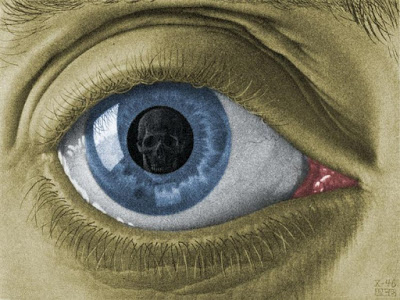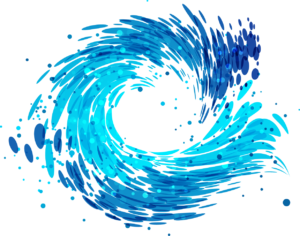 |
| Eye Color by M.C. Escher |
Q: I’m interested in discussion regarding yoga and retina issues. Cautions and options for yoga after retina repair and doctor permission to return to class.
A: Thanks for your question regarding practicing safely with eye related concerns, specifically cautions and options for yoga after retina repair and doctor permission to return to class. This is not an uncommon concern among some of my students. In fact it came up again this past month, when a student had to undergo laser treatment to the retina for a partial tear to the back surface of the eye. His doc recommended avoiding inverting for a full two weeks. And I suspect given individual circumstances, you can expect even longer periods of rest from inverting before safely re-introducing poses like down dog to your practice.
I suggested to my student that he could modify many of his poses and still practice safely at home and in class. For instance, I suggest Half Standing Forward Bend instead of classic Standing Forward Bend, Half Downward-Facing Dog pose at the Wall instead of classic Downward-Facing Dog pose. It might also be good to avoid holding poses for a long time, as there could be a corresponding rise in blood pressure that could negatively influence the pressure in the eyes. Focusing on restorative poses, calming pranayama (breath practices), and yoga nidra (guided relaxation) would likely support healing.
—Baxter
Follow Yoga for Healthy Aging on Facebook ° To order Yoga for Healthy Aging: A Guide to Lifelong Well-Being, go to Amazon, Shambhala, Indie Bound or your local bookstore.


I learned to monitor this after my own retina repair recently and modified my poses much as you suggested. I also experienced dizziness in any poses with the head below the waist. Now the dizziness has abated but I still monitor any pressure behind the eyes and make my modest inversions brief.
Every case is different but this is what I have been told after my recent retinal tear–no bending from the waist till healing has taken place, no sun salutations at all for at least four weeks, no inversions at all ever. I never did do headstands and handstands, and did the shoulderstand every now and then without holding for more than a few seconds, gave up plough a long time ago due to very thin retina. It is important for people with high myopia (they have thin retinas) to not do any inversions such as headstands, handstands, and not hold downward dog, no chaturanga, and any other position where the head is held below the waist.
My brother-in-law, a highly regarded doctor, said NO YOGA ASANAS for at least four weeks. After that, check with the doctor before doing any poses.
As a yoga therapist, I would even tell people to avoid any breath retention in pranayamas. Yoga Nidras are perfectly good.
Dear Meena
I was glad to come across your post as i recently underwent laser for my retina.
I have been very disheartened after learning about certain postures i need to avoid in the future. I plan on taking 2 months off practise.
I wanted to know if it would be safe to do uttanasana and if i can hold downward down for 3 breaths when i return to my practise ? And would it be ok to do the chaturanga variation where u bring ur knees down to the mat first ?
Is there any issues doing high planks ?
And want about running and rock climbing … I have been athletic my whole life and i am so confused about what kind of physcial activity i can continue to enjoy .
Looking fw to your feedback.
Thank u
Eye surgery comes with certain precautions post op that need to be followed. My recommendation is to talk to the eye surgeon about your practice of yoga and be specific about what it is you do. You are asking if you can put your head in a dependent position which will increase eye pressure. Tell the doctor that you want to know what ( if any ) precautions there are with;
1. dependent head positions (if there are precautions what is the time limitation or sensory perception to be aware of) in forward standing bends of which uttanasana and dog pose would be in this category
2. effort. Chataranga, dog pose are specific weight bearing poses that can if there is breath holding increase upper body tension, neck tension, fascial tension which may or may not affect eye musculature tension. I am not sure what you mean by "high planks" but any pose that increases upper body tension may or may not have overflow into facial and eye musculature.
3. running is an aerobic activity and that is a specific way to ask the doc the precautions of aerobic activity on eye pressure.
4. rock climbing again is a strenuous upperbody activity so can be subcategorized under "effort and upper body usage"
I am sorry that I can't be more specific in the do's or don'ts of your proceedure but approaching your practitioner is always the best recommendation of how to return to doing the activities that you love.
—Shari Ser